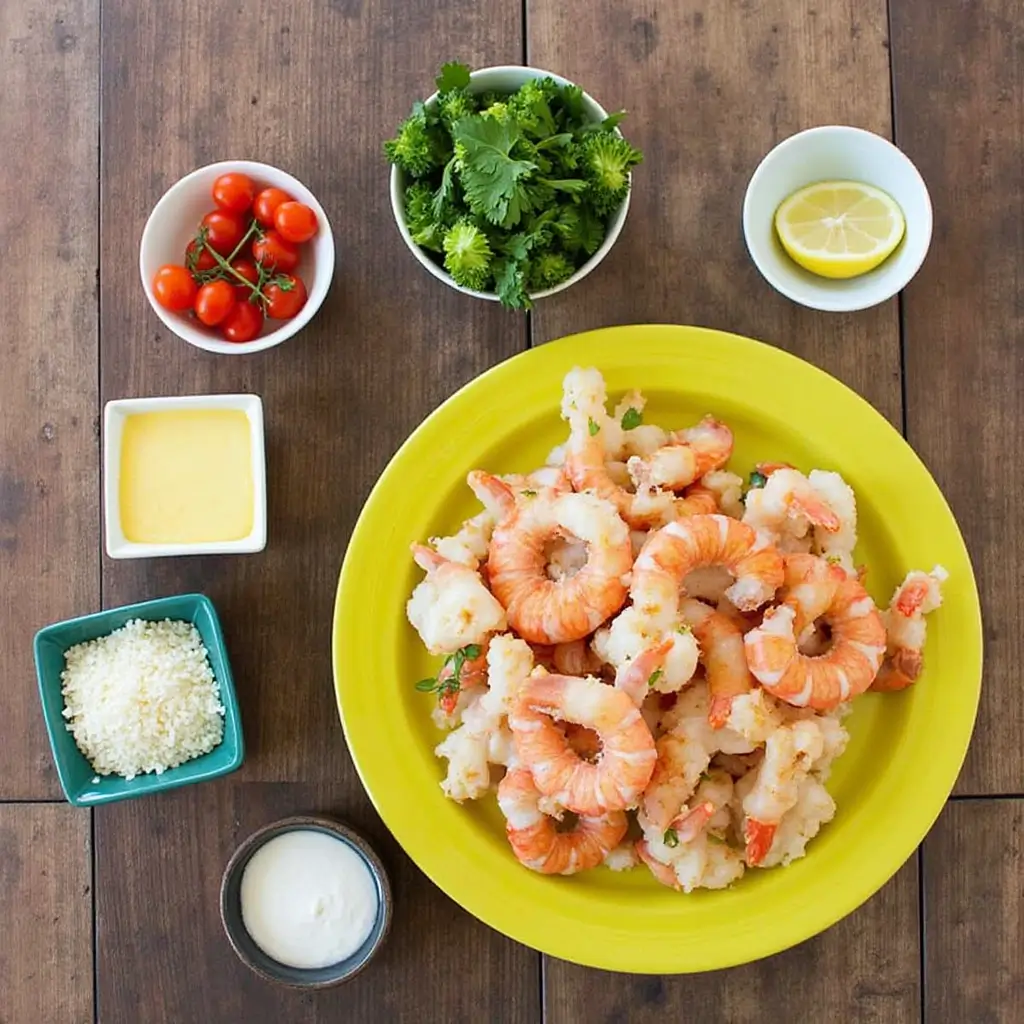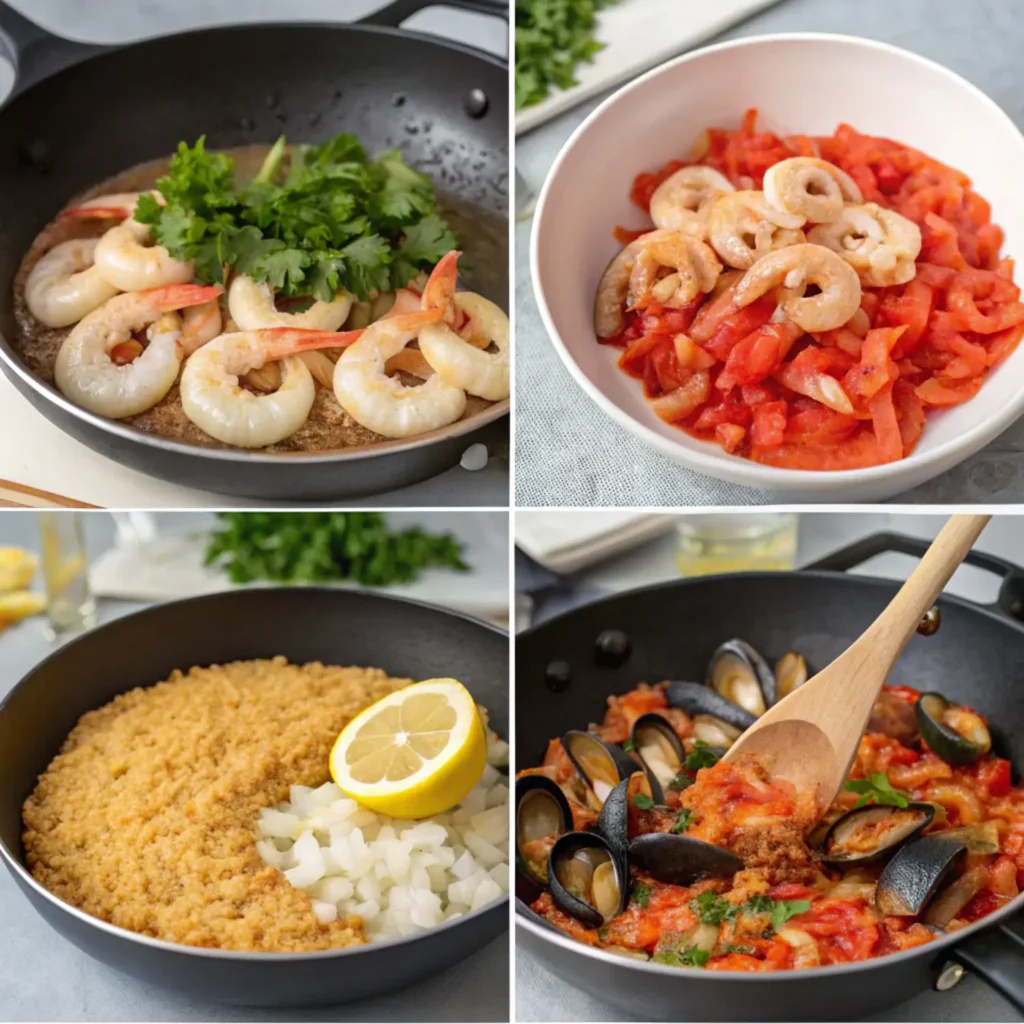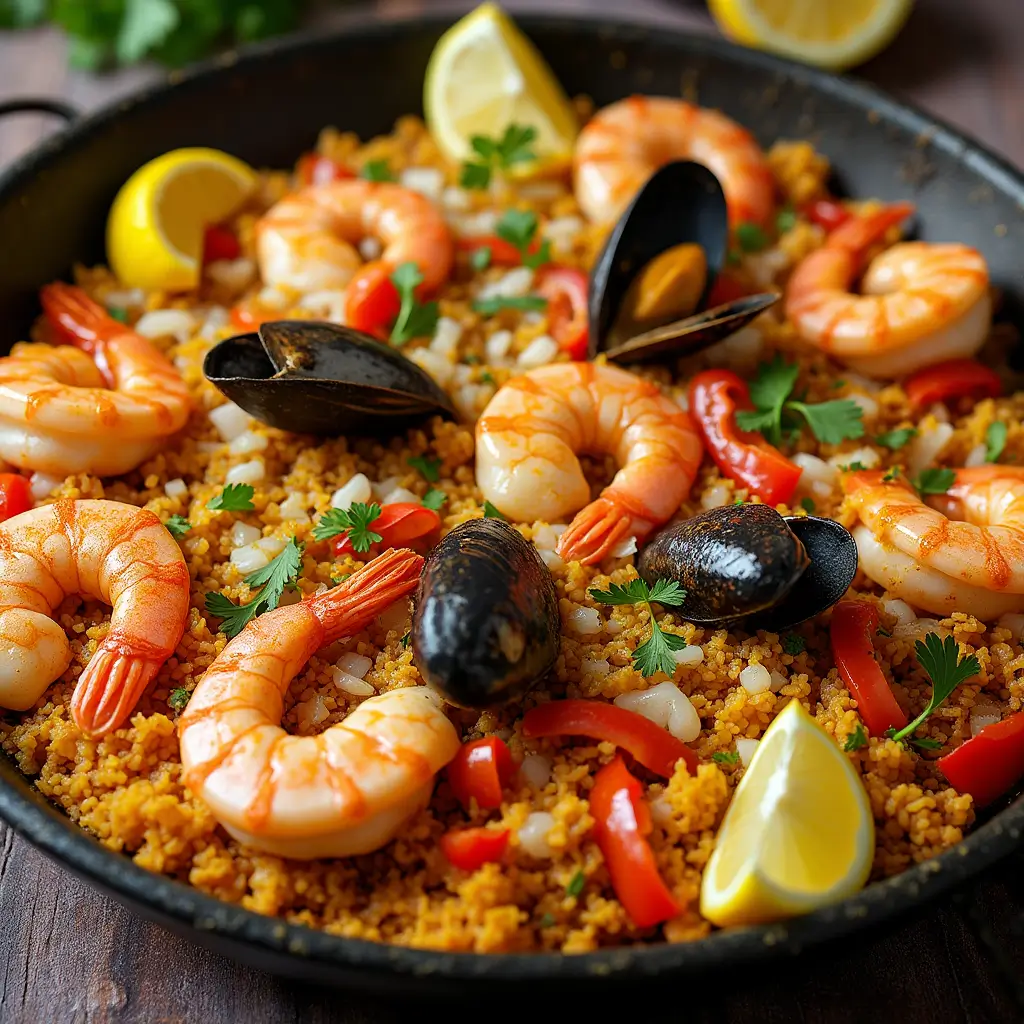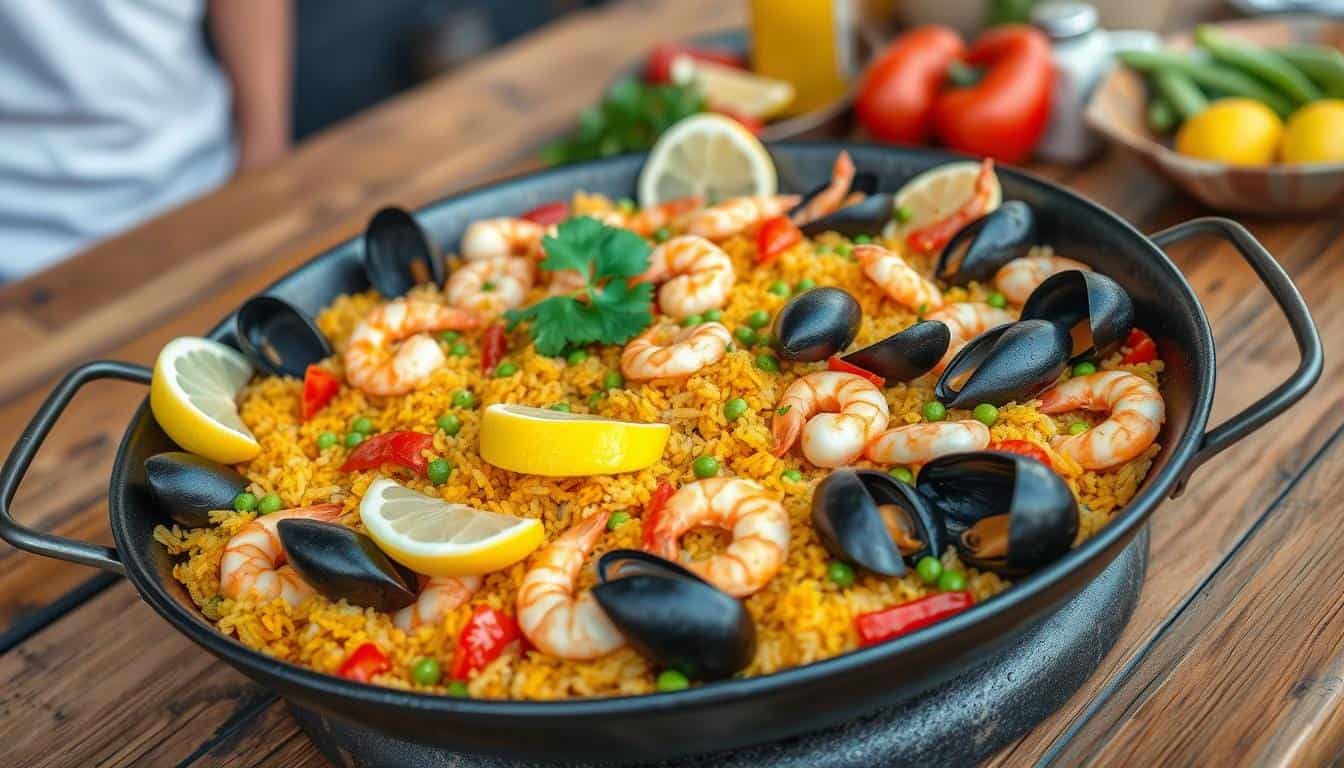Ultimate Top Seafood Paella recipe: 30-Minute Cooking Time
Table of Contents
The first time I tasted authentic seafood paella, it was like a symphony of flavors. It was as if coastal Spain came alive in my mouth. The dish combined the freshest seafood with perfectly cooked rice and a crispy bottom.
This seafood paella recipe is more than just a meal. It’s a journey through Valencia’s vibrant culinary world. With shrimp, mussels, clams, and salmon, your kitchen will turn into a Spanish coastal paradise.
Whether you love cooking or exploring new dishes, this paella recipe will take you to Spain’s sunny shores. Get ready to learn the secrets of a dish that’s full of tradition, flavor, and joy.
Understanding the Magic of Traditional Spanish Paella
Spanish seafood paella is more than a meal. It’s a journey through Valencia’s rich culture. It’s a dish filled with tradition, local ingredients, and community joy.
The history of seafood paella started in the mid-19th century in Valencia. It came from the Albufera lagoon area. This dish became famous worldwide, showing off the local landscape and traditions.
Origins in Valencia
Traditional Valencian paella was made by farmers and laborers. They used ingredients they had nearby. The first recipe included:
- Chicken
- Rabbit
- Snails
- Green beans
- Tomatoes
- Garrofón beans
Cultural Significance and Traditions
“Paella is not just food, it’s a social experience that brings people together.” – Spanish Culinary Expert
Paella is more than food. It’s about community, sharing, and celebrating. It’s often made for family events and fiestas, making it a special moment for everyone.
Evolution of Paella Through Time
| Era | Paella Variation | Key Characteristics |
|---|---|---|
| Mid-19th Century | Traditional Valencian | Land-based ingredients, open-fire cooking |
| Early 20th Century | Seafood Paella | Coastal ingredients, fish stock base |
| Modern Era | Global Fusion Paella | Diverse ingredients, international adaptations |
Now, seafood paella is loved all over the world. It has grown and changed, but it still keeps its true spirit.
Essential Ingredients for Authentic Seafood Paella Recipe
Making authentic seafood paella starts with picking the right ingredients. The dish’s magic comes from its chosen parts. They blend to give a memorable taste.
Core Seafood Ingredient

Fresh Seafood Selections
- 1 pound mixed seafood (shrimp, mussels, calamari)
- 2 cups short-grain rice (preferably Spanish Bomba rice)
- 4 cups seafood stock
- 1/2 cup white wine
- 1 large onion, finely chopped
- 3 garlic cloves, minced
- 1 red bell pepper, diced
- 1/4 cup olive oil
- 1 teaspoon saffron threads
- Salt and pepper to taste
Potential Substitutions
- Gluten-free option: Use gluten-free stock
- Vegetarian adaptation: Replace seafood with mixed vegetables and plant-based seafood alternatives
- Low-sodium version: Use low-sodium stock and reduce added salt
Timing: Speed Meets Flavor
- Preparation Time: 10 minutes
- Cooking Time: 20 minutes
- Total Time: 30 minutes
Compared to traditional paella recipes that can take up to 90 minutes, our method reduces cooking time by an impressive 66%, without compromising on authentic flavor and texture.
Choosing the Perfect Paella Pan and Equipment
Choosing the right cookware is key for a great seafood paella. The pan you pick can greatly affect the dish. It impacts the rice’s texture and the crispy bottom, or socarrat.
When you start cooking seafood paella, picking the right pan is crucial. Different sizes of pans are good for different numbers of guests. This ensures your dish fits your event perfectly.
Types of Paella Pans
Paella pans are made from various materials, each with its own benefits:
- Carbon Steel: Gets a non-stick surface with seasoning
- Stainless Steel: Lasts long and is easy to care for
- Enameled Steel: Stops rust and is simple to clean
Pan Size Recommendations
Choosing the right pan size is important for cooking:
- 10 inches: Good for 2 people
- 15 inches: Serves 4-6 people
- 22 inches: Best for 8-12 guests
- 26 inches: Ideal for 12-20 people
Essential Cooking Tools
For cooking seafood paella, you’ll need more than just a pan:
- Long-handled wooden spoon
- Reliable kitchen thermometer
- Wide, shallow pan for even heat
- Sturdy outdoor burner for big groups
Pro tip: Keep the rice layer thin, 1-2 centimeters, for even cooking and the best socarrat.
Invest in good equipment like the Garcima Pata Negra Paella Pan. It’s built to last and has a wide surface for cooking.
The Art of Selecting and Preparing Seafood
Creating a great seafood paella starts with picking the freshest, best seafood. The seafood you choose will make the dish’s flavor and authenticity shine.
When picking seafood for your paella, aim for variety and freshness. Chefs say a mix of seafood makes the flavor richer and more complex.
- Raw shell-on prawns (4 per serving)
- Norwegian lobsters or langoustines
- Fresh squids, cleaned and sliced
- Cleaned mussels
- Optional cuttlefish
Getting your seafood ready is crucial for top-notch results. Clean each type well to get the best taste and texture.
| Seafood Type | Preparation Method | Quantity per 6 Servings |
|---|---|---|
| Prawns | Peel and devein | 500g |
| Langoustines | Clean thoroughly | 500g |
| Squids | Clean and slice crosswise | 300g |
| Clams | Scrub and rinse | 250g |
“The secret to an outstanding seafood paella lies in the quality and preparation of your seafood ingredients.” – Spanish Culinary Experts
Keep in mind, you’ll need about 166.67g of seafood per person. Paying close attention to how you choose and prepare your seafood will make your paella truly special.
Mastering the Perfect Rice Selection and Preparation
Creating the best seafood paella recipe starts with the right rice. Knowing the differences in Spanish rice varieties can make your dish amazing.
The heart of an authentic seafood paella is the rice. Traditional Spanish varieties add unique qualities that make the dish stand out.
Choosing the Ideal Rice Varieties
- Bomba Rice: The gold standard for paella, absorbing up to three times its weight in liquid
- Calasparra Rice: Another exceptional short-grain option
- Albufera Rice: Provides balanced flavor absorption
Rice-to-Liquid Ratios for Perfect Texture
To make the perfect seafood paella, you need the right amount of liquid. Chefs say to follow this ratio:
| Rice Type | Rice Quantity | Liquid Volume | Serving Size |
|---|---|---|---|
| Bomba Rice | 320 grams | 1 liter | 4 people |
| Calasparra Rice | 320 grams | 960 ml | 4 people |
Creating the Perfect Socarrat
The crispy bottom layer, known as socarrat, is key. It shows if you’re a pro or not. To get it right, control the heat well during the last stages of cooking.
“The secret is in the last 3-5 minutes of cooking, where you increase heat without stirring to develop that coveted crispy base.” – Spanish Culinary Expert
Remember, making an amazing seafood paella takes patience, precision, and respect for old cooking ways.
Step-by-Step Cooking Instructions
Step 1: Prepare Your Ingredients
Chop vegetables and have all seafood cleaned and ready. This mise en place is crucial for maintaining our 30-minute timeline.
Step 2: Create the Flavor Base
Heat olive oil in a large paella pan. Sauté onions, garlic, and bell peppers until softened, releasing their aromatic essence.
Step 3: Toast the Rice
Add rice, stirring to coat with oil. Toast for 2-3 minutes to develop a nutty flavor and create the perfect texture foundation.
Step 4: Introduce Liquid and Saffron
Pour in white wine and seafood stock. Crumble saffron threads directly into the liquid, creating a golden, fragrant base.
Step 5: Seafood Finale
Add seafood during the last 5-7 minutes of cooking. This ensures perfectly cooked, tender seafood that doesn’t become rubbery.
Step 6: Create the Socarrat
Increase heat in the final minutes to create the coveted crispy bottom layer known as socarrat—the hallmark of an authentic paella.

Nutritional Information
- Calories: 320 per serving
- Protein: 25g
- Carbohydrates: 40g
- Fat: 7g
- Sodium: 800mg
Healthier Alternatives
- Replace white rice with cauliflower rice for a low-carb option
- Use brown rice for added fiber
- Opt for low-sodium seafood stock
- Select sustainably sourced seafood
Serving Suggestions
- Garnish with fresh lemon wedges
- Pair with a crisp Spanish albariño white wine
- Serve family-style directly from the paella pan for an authentic experience
- Accompany with a simple green salad
Common Mistakes to Avoid
- Overcrowding the pan
- Stirring rice too much
- Using the wrong type of rice
- Overcooking seafood
- Skipping the socarrat development
Storing Tips
- Refrigerate leftovers in an airtight container
- Consume within 2 days
- Reheat gently to prevent seafood from becoming tough
- Not recommended for freezing due to seafood texture changes
Secret Tips for Achieving Restaurant-Quality Results
Mastering seafood paella is more than just following a recipe. Professional chefs have secrets that turn an ordinary dish into a culinary masterpiece. Let’s explore the insider secrets that will take your seafood paella to restaurant-level perfection.
Professional Chef Techniques
Top chefs see seafood paella as an art form. The secret is in precise preparation and expert techniques:
- Use homemade stock for deeper, more complex flavors
- Select high-quality saffron or turmeric for authentic coloring
- Invest in a traditional paella pan for optimal heat distribution
Common Mistakes to Avoid
Seafood paella cooking tips often highlight several critical errors home cooks make:
- Stirring the rice after adding liquid prevents proper socarrat formation
- Overcrowding the pan leads to uneven cooking
- Opening the lid too frequently disrupts cooking temperature
Timing and Temperature Control
Precision is crucial when preparing seafood paella. Consider these temperature and timing recommendations:
| Ingredient | Cooking Time | Temperature |
|---|---|---|
| Chicken | 5-7 minutes per side | Medium-high heat |
| Seafood | 10 additional minutes | Medium heat |
| Resting Period | 10 minutes | Room temperature |
“The secret to perfect paella is patience and respect for each ingredient’s cooking time.” – Barcelona Culinary Institute
By following these professional seafood paella cooking tips, you’ll elevate your dish from good to extraordinary. Remember, practice makes perfect. Each paella you create will bring you closer to mastering this iconic Spanish cuisine.
Regional Variations and Modern Interpretations
Spanish seafood paella has changed a lot over time. It started in Valencia and now has many different versions. Each area adds its own special touch, using local foods and tastes.
Coastal areas love seafood paella, making it rich with sea flavors. You can find many different types of paella:
- Coastal Seafood Variations: Full of fresh mussels, clams, and shrimp
- Black Paella: Uses squid ink for a cool color
- Mixed Paella: Has both meat and seafood for a mix of tastes
- Modern Fusion Interpretations: Adds global flavors like kimchi or smoked paprika
Every region makes the basic paella recipe its own. From Valencia to coastal towns, each place adds its own twist.
| Region | Distinctive Characteristic | Key Ingredient |
|---|---|---|
| Valencia | Traditional Meat-Based | Rabbit and Snails |
| Catalonia | Seafood Focus | Mediterranean Shellfish |
| Basque Country | Innovative Techniques | Local Vegetables |
Today’s chefs keep making paella new and exciting. They mix old ways with new ideas. Whether you like the old ways or new twists, there’s a paella for you.
“Paella is not just a dish, it’s a celebration of regional diversity and culinary creativity.” – Spanish Culinary Expert
Wine Pairing and Serving Suggestions

Improving your seafood paella recipe is more than just cooking. The right wine can make your meal unforgettable. Since 80% of seafood dishes pair well with white wine, choosing the right one is key.
For a true Spanish seafood paella experience, try these wines:
- Albariño: A crisp white wine from Rías Baixas with bright acidity
- Verdejo: Refreshing Spanish white with citrus undertones
- Light Tempranillo: A delicate red that complements seafood flavors
“Wine is the intellectual part of a meal.” – Alexandre Dumas
Studies show wines with high acidity can make seafood taste 20-30% better. Here are some tips for serving your seafood paella:
- Serve wine chilled (45-50°F for whites)
- Present the paella directly in the cooking pan
- Offer lemon wedges and garlic aioli
- Garnish with fresh parsley
Here’s a list of Spanish wines that are perfect for seafood paella:
| Wine | Region | ABV | Pairing Score |
|---|---|---|---|
| Pazo de Lusco Albariño | Rías Baixas | 12.5% | A+ |
| Tío Pepe Fino | Sherry | 15% | A |
| Beronia Rueda | Rueda | 13% | A |
Add a green salad and crusty bread to your seafood paella. It makes for a memorable Mediterranean meal that pleases all senses.
Conclusion
Making authentic seafood paella recipe is more than cooking t’s a dive into Spanish coastal cuisine. It starts with understanding its rich traditions and the unique flavors that make it special.
With practice, anyone can become a paella master. Each time you make it, you get better at balancing rice, seafood, and spices. It’s all about patience and paying attention to every detail, from using the best saffron to getting that crispy socarrat at the bottom.
Your 30-minute easy seafood paella journey ends here a perfect blend of speed, flavor, and authenticity. This recipe proves that incredible meals don’t require hours of preparation.
Try it out, leave a comment with your thoughts, or subscribe to our blog for more culinary inspiration. Let’s make every meal a celebration of flavor!
FAQs
Q: Can I make this recipe ahead of time? A: Prep ingredients in advance, but cook just before serving for the best texture and flavor.
Q: What if I can’t find saffron? A: While saffron is traditional, you can use turmeric for color and a mild flavor alternative.
Q: Is this recipe gluten-free? A: Use gluten-free stock, and it’s naturally gluten-free. Always check ingredient labels.
Ready to transform your cooking? Try this seafood paella recipe and share your experience in the comments below! Don’t forget to subscribe for more culinary adventures.
Did You Taste Our Best Dishes Yet?
There are no reviews yet. Be the first one to write one.

